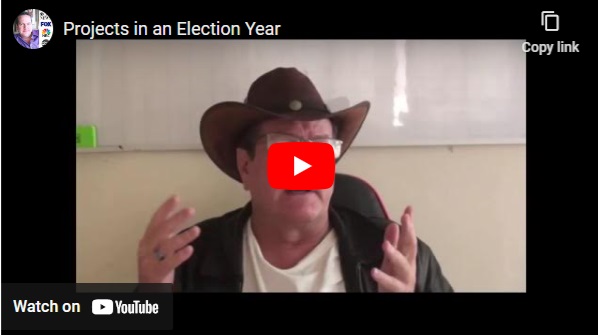Projects in an Election Year
Investing in new projects during a presidential election year can be a complex decision, fraught with both unique opportunities and distinct challenges. This is called risk. Let’s face it, the country, whatever country you are in, always seems to be screwed and you are just hoping for a new and better future whatever idiot is elected. You are usually left with the Tweedle Dee and Tweedle Dumb party for choices.
The political and economic landscape can shift significantly based on election outcomes, influencing market confidence, regulatory environments, and fiscal policies. Additionally, it is not just your personal perspective that counts, but also the perspective of your customer and investors. Here’s a comprehensive look at the factors to consider when contemplating investments in such a politically charged period.
Understanding Market Volatility
Presidential election years are typically marked by increased market volatility. Investors often react to the uncertainty of potential policy changes and the political rhetoric that dominates the media. Historically, markets can experience short-term dips and spikes as polls fluctuate and candidates’ platforms evolve. For instance, sectors that heavily depend on government policies, such as healthcare, energy, and defense, might experience significant swings as investors speculate on how new leadership could impact regulations and spending.
Risk and Reward Analysis
Investing in new projects during this time necessitates a keen understanding of risk management. It’s essential to analyze the potential for both positive and negative outcomes, which includes them there categories below.
Regulatory Changes
Different candidates often propose varied regulatory frameworks. A new administration might bring deregulation or increased regulation in specific industries, impacting project feasibility and profitability. I once pitched a distillery in a dry city and got them to change the law and allow people to drink. This is always a factor.
Fiscal Policies
Tax policies, government spending, and fiscal stimulus plans can change dramatically with a new administration, affecting both consumer spending and business investment. This often impacts schedules because you want to complete your project while you can.
Economic Indicators
Factors such as interest rates, inflation, and unemployment rates can shift based on anticipated or actual changes in government policies, impacting the overall economic environment for new investments.
Strategic Timing and Diversification
Timing Investments
Timing is crucial when investing in an election year. Investors might choose to delay large commitments until after the election results are clear, to better understand the regulatory and economic outlook. However, this strategy can mean missing out on early opportunities. Alternatively, some investors might capitalize on pre-election volatility to invest in undervalued assets or sectors poised for growth under specific policy outcomes.
Diversification
Diversifying investments can mitigate risks associated with election year uncertainties. Spreading investments across various sectors and asset classes can help buffer against sector-specific volatility. For instance, if a particular sector is adversely affected by anticipated regulatory changes, gains in other sectors can help balance the overall portfolio performance.
Sector-Specific Considerations
Healthcare
The healthcare sector is often at the center of election debates, with potential shifts in policy regarding insurance coverage, pharmaceutical regulations, and healthcare funding. Investors should stay informed about candidates’ healthcare platforms and potential impacts on various segments within the sector.
Energy
Energy policies, including renewable energy initiatives, fossil fuel regulations, and environmental policies, can change significantly with a new administration. Investors should consider how different outcomes might affect energy production, infrastructure, and innovation within the sector.
Technology
Technology and innovation policies can influence funding for research and development, intellectual property regulations, and international trade policies. The stance of presidential candidates on issues like net neutrality, cybersecurity, and tech company regulations can play a pivotal role in shaping the tech investment landscape.
Political Climate and Market Sentiment
The political climate during an election year can also influence market sentiment and investor confidence. Political stability, public sentiment towards candidates, and the overall political environment can either bolster or undermine market confidence. Keeping a pulse on these factors can provide insights into potential market movements and help investors make informed decisions.
Sentiment Analysis
Investors can utilize sentiment analysis tools to gauge public and market sentiment towards different candidates and their policies. This can offer valuable insights into potential market reactions and help investors align their strategies with anticipated market trends.
Long-Term Perspective
While the immediate effects of a presidential election can be significant, it’s important to maintain a long-term perspective. Short-term market reactions often normalize once election uncertainties are resolved and the new administration’s policies become clearer. Historical data suggests that markets tend to recover and grow over time, regardless of the election outcome.
Building Resilient Portfolios
Building resilient investment portfolios that can withstand short-term volatility while positioning for long-term growth is crucial. This involves a balanced approach, combining defensive investments with growth opportunities that align with anticipated policy directions. This is often the safest approach although like every investment putz out there, I will say, I am not giving you advice.
Conclusion
Investing in new projects during a presidential election year requires careful consideration of various factors, including market volatility, regulatory changes, and sector-specific impacts. By adopting strategic timing, diversification, and maintaining a long-term perspective, investors can navigate the uncertainties and position themselves for potential growth opportunities. Staying informed about political developments and market sentiment can further aid in making well-informed investment decisions during this tumultuous period. However, keep in mind, I am a real cowboy. I don’t just play one on TV.
Let’s Git-R-Done this week!

